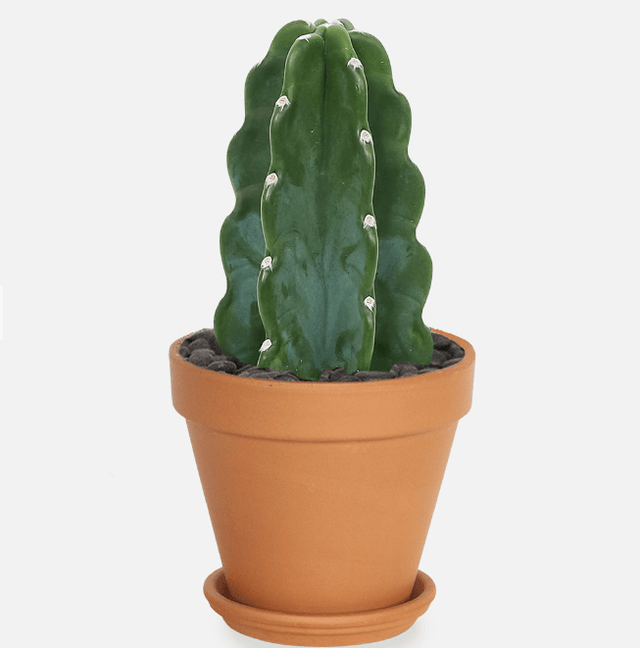
Cactus

Euphorbia 'Pencil Cactus'
Botanical Name: Euphorbia tirucalli Common Names: Pencil Cactus, Indian tree spurge, Description: The Pencil Plant or Euphorbia Tirucalli is a succulent native to South and East Africa. The plant’s namesake branches are pencil-like and grow upward in a candelabra pattern. Young branches are cylindrical, smooth, and green, but with age can turn gray and rough like tree bark. Its leaves are small and slender and fall off quickly. This succulent yields a highly toxic milky sap if broken or torn. The Pencil Plant is otherwise very agreeable, surviving in nearly any condition that is both dry and above freezing. In favorable conditions, it is able to grow between two and 20 inches in a single season.
$48.16 - $219.04

Boobie Cactus | Live Plant for Indoor & Outdoor | House Plant Decor
The "Boobie Cactus," scientifically known as Myrtillocactus geometrizans 'Fukurokuryuzinboku', is a monstrose cultivar (a plant with unusual growth patterns) of the Myrtillocactus geometrizans (Blue Candle Cactus) with distinctive, breast-like bumps and small spines, making it a unique and popular collector's item. The "Boobie Cactus" is a rare, monstrose cultivar with distinctive, breast-like bumps and small spines. Perfect for indoor and outdoor spaces, this unique and popular collector's item adds a touch of quirky charm to any house plant decor.
$37.20 - $77.70

Road Kill Cactus (Consolea rubescens) | Live Plant for Indoor & Outdoor | House Plant Decor
Botanical Name: Consolea rubescens Common Name(s): Roadkill Cactus Description: The Consolea rubescens ("Road Kill Cactus"), begins as a normal-looking Opuntia species. As it matures, it takes on a tree-like form. It sports a cylindrical, woody trunk with a small rounded top. Spination on trunk is variable (naked or spiny). This cactus has an impressive mature height of 20' with a mature width of 8'. Air Purification: Indoor plants act as natural air purifiers by absorbing pollutants and toxins, such as formaldehyde and benzene, through a process called phytoremediation. They release oxygen and improve air quality, creating a healthier living environment. Stress Reduction: Studies have shown that the presence of indoor plants can reduce stress and enhance overall well-being. The visual appeal of greenery and the act of caring for plants can contribute to a calming atmosphere, promoting relaxation and mental clarity. Humidity Regulation: Indoor plants release water vapor during a process called transpiration, which helps regulate humidity levels in enclosed spaces. This can be particularly beneficial in dry indoor environments, providing a more comfortable and balanced atmosphere for occupants. Aesthetic Enhancement: Indoor plants add a touch of nature and aesthetic appeal to interior spaces. Whether it's a vibrant flowering plant, a cascading vine, or a lush foliage plant, they contribute to the overall decor, making rooms more visually appealing and inviting.
$24.90 - $48.40

Opuntia 'Microdasys' (Bunny Ear Cactus)
Botanical Name: Opuntia microdasys Common Names: Bunny Ear Cactus, Angel's Wings, Polka-Dot Cactus, Bunny Cactus Description: The Bunny Ear Cactus is a popular succulent that belongs to the Opuntia genus and is native to Mexico. The plant is named for its distinctive flattened, pad-shaped stems that resemble bunny ears. The stems are covered in soft, white spines that are harmless to the touch and give the plant a unique, fuzzy appearance. The Bunny Ear Cactus produces bright yellow flowers in the spring and summer that are followed by edible red fruit. The plant is easy to care for and can be grown indoors or outdoors in a sunny, well-draining location. It prefers dry soil and can tolerate periods of drought.
$26.00

Drooping Prickly Pear Cactus
Botanical Name: Opuntia monacantha Common Names: Prickly Pear Cactus Description: Opuntia monacantha is a succulent perennial cactus species from the Cactaceae family, originating from South America. This plant is a popular choice for growing as a houseplant, it is low maintenance, requiring good sunlight and infrequent watering. Produces showy flowers up to 10cm in length and between 3-7.5cm, they are borne on fleshy bases, appearing from the stem margins.
$26.00 - $48.00

Starfish Cactus (Stapelia orbea variegata)
Botanical Name: Stapelia orbea variegata Common Names: Starfish Cactus, Starfosh Flower Description: Orbea variegata is commonly known as Starfish Plant, Carrion Plant, or Starfish Cactus. It is native to South Africa and belongs to the Asclepiadaceae family. The Stapelia Orbea variegata grows erect, branching above ground and forming clumps, reaching a height of 10 cm. The flower of this plant is starfish-shaped, greenish-yellow with brown patches or blotches. It flowers in late summer or autumn. The plant is mildly frost-hardy and grows at a fast pace when exposed to the right conditions. This summer-dormant plant needs light shade to full sun for impressive growth.
$28.00

Cereus forbesii 'Spiralis'
Botanical Name: Cereus forbesii 'Spiralis' Common Name(s): Spiral Cactus Description: Step into the captivating world of the spiral cactus, scientifically known as Cereus forbesii ‘spiralis,’ a botanical treasure from Peru. While growing in popularity, the spiral cactus remains more elusive than its common counterparts. Once mature, this striking cactus can soar to heights of 6 to 13 feet, boasting a diameter of 4 to 5 inches, and is one of the fastest-growing cactus varieties, rewarding caretakers with swift growth.
$128.00 - $172.00

Zygocactus 'Christmas Cactus' | Live Plant for Indoor & Outdoor | House Plant Decor
Botanical Name: Schlumbergera truncata Common Names: Zygocactus, Christmas Cactus Description: Zygocactus also known as Thanksgiving cactus, holiday cactus, or crab cactus. The crab name refers to the leaf-shaped stem segments that have curved, pointed teeth or claws along the edges. The Easter cactus (Schlumbergera buckleyi) has rounded edges on its leaf segments.
$22.88 - $52.80

Peperomia 'Axillaris'
Botanical Name: Peperomia Common Names: Cactus Limon Description: Peperomia Axillaris is a precious little shrub-like succulent with translucent-green peapod-like leaves. They like bright light but don't need direct sunlight. A peperomia flower stalk is covered with teeny-tiny flowers that have no scent.
$52.00

Epiphyllum 'Ric Rac' Cactus
* Botanical Name: Cryptocereus anthonyanus* Common Names: Ric Rac cactus, Zig Zag, Fishbone* Description: The common name of this plant refers to the pattern of the grooves of this cactuses foliage, which closely resembles the skeleton of a dead fish. When matured this plant's leaves grow in an arch over the pot and is extremely resilient as it retains a lot of water as it is considered a cactus. This cactus can tolerate in indirect and bright sunlight making it a great choice for novice gardeners.
$30.00 - $80.00

Orchid Cactus 'Curly Sue' - 6" Pot
Botanical Name: Epiphyllum guatemalense Common Names: Orchid Cactus 'Curly Sue' Description: The foliage of this Epiphyllum wants to twist and curl into great locks of flat, rich green foliage. Rather small for an Epiphyllum, the 3″ white flowers open at night and may be followed by small red, delicious, edible fruit.
$76.00

Senecio Stapeliiformis Pickle Plant
Botanical Name: Senecio Stapeliiformis Common Names: Pickle Plant Description: The pickle plant is a succulent perennial native to South Africa. This flowering succulent wields segmented pencil like stems which can grow up to 10 inches tall, giving it the appearance of a very skinny cactus as there are soft spines along its stalks.
$16.00 - $74.40

Rat Tail Cactus
Botanical Name: Huernia insigniflora Common Names: Rat Tail Cactus Description: Plant enthusiasts worldwide grow Huernias indoors because of their interesting stem shapes and colors. Lifesaver plants can be grown as intriguing indoor, greenhouse or summer patio container plants almost anywhere. Huernias require a potting mix with excellent drainage.
$28.00 - $88.00

Lifesaver Cactus
Botanical Name: Huernia insigniflora Common Names: Lifesaver Cactus Description: Plant enthusiasts worldwide grow Huernias indoors because of their interesting stem shapes and colors. Lifesaver plants can be grown as intriguing indoor, greenhouse or summer patio container plants almost anywhere. Huernias require a potting mix with excellent drainage.
$36.00 - $80.00

Milkstripe Euphorbia
Botanical Name: Euphorbia lactea Common Names: Milkstripe, Mottled Spurge, Mottled Candlestick, Dragon Bones Tree Description: A succulent plant that’s adapted to arid conditions, this euphorbia thrives in both full sun and bright, indirect light. The common name “milkstripe” is due to an irregular yellowish-white band in the center of the plant’s three-or-four-sided, somewhat prickly stems. When repotting, use only soil designed for cactus and succulents, and select containers with ample drainage holes.
$20.00

Succulent 'String of Bananas'
Succulent will arrive in 4" pot. Plants may vary slightly from the pictures.All succulents are carefully packed for shipment and will arrive in great condition and ready to enjoy.Succulents are expedited to make sure they arrive healthy and in a timely manner.The string of Bananas is a trailing succulent and can thrive in a hanging pot.--Succulent plants are trendy for a reason. With juicy leaves, stems, or roots, succulents form a vast and diverse group of plants, offering easy-care choices for your home. Plus, they look stunning planted alone or as companions. The color variation of succulents seems almost endless: blue-green, chartreuse, pink, red, yellow, white, burgundy, almost black, variegated, and more. The leaves may be rounded, needlelike, berrylike, ruffled, or spiky. Many have an enticing "touch-me" quality. Light Most varieties need at least half a day to a full day of sunlight. In extremely hot areas some afternoon shade is recommended. Planting Remove plants from their pots and plant making sure the soil level remains the same depth on the plant. Once established, your succulents will benefit from a layer of pebbles or pea gravel spread on the soil around the plant. This is also very decorative. Soil Succulents need good draining soil. When planting in the garden, make sure the area drains well and is not in a low spot that would stay wet. For container planting you can purchase cactus soil or incorporate sand, gravel or volcanic rock for better drainage. The container you are planting in should have a drainage hole or put crushed rock on the bottom before your planting medium. Watering After planting, water in well and allow the soil to dry slightly between waterings. Succulents don't like to have wet feet. When you do water, water thoroughly. Uses The planting possibilities using succulents are endless. The different colors, textures and habits make the most interesting containers and troughs. Succulents make beautiful rock garden plants. With a wide variety of bloom times there is always something with color. FEATURES
$28.00 - $68.00

















